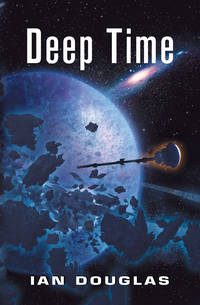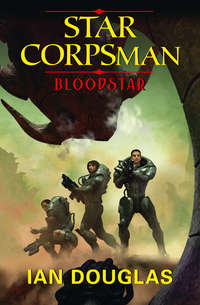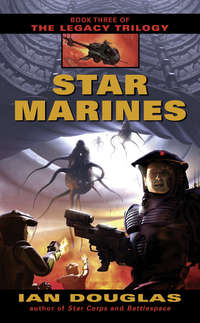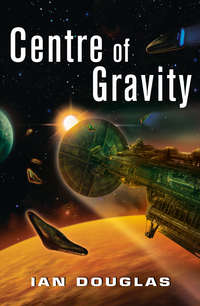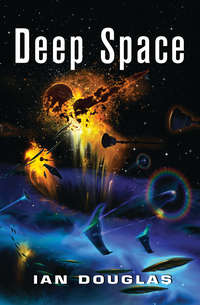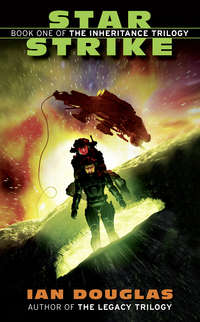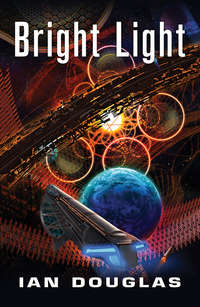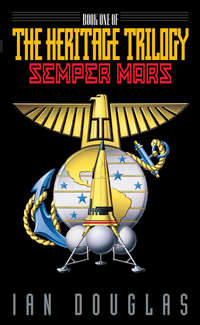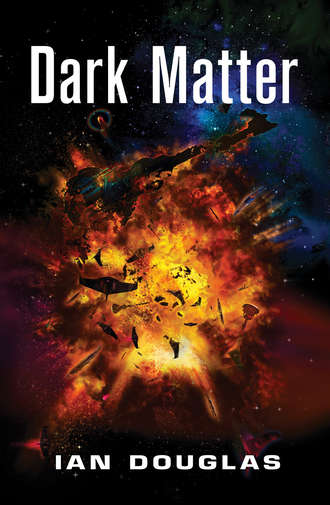
Полная версия
Dark Matter



Copyright
Harper
An imprint of HarperCollinsPublishers Ltd
1 London Bridge Street
London SE1 9GF
www.harpercollins.co.uk
First published in Great Britain by HarperCollinsPublishers 2014
Copyright © Ian Douglas 2014
Cover Art © Gregory Bridges
Ian Douglas asserts the moral right to be identified as the author of this work.
A catalogue copy of this book is available from the British Library.
This novel is entirely a work of fiction. The names, characters and incidents portrayed in it are the work of the author’s imagination. Any resemblance to actual persons, living or dead, events or localities is entirely coincidental.
All rights reserved under International and Pan-American Copyright Conventions. By payment of the required fees, you have been granted the non-exclusive, non-transferable right to access and read the text of this e-book on screen. No part of this text may be reproduced, transmitted, down-loaded, decompiled, reverse engineered, or stored in or introduced into any information storage and retrieval system, in any form or by any means, whether electronic or mechanical, now known or hereinafter invented, without the express written permission of HarperCollins.
Source ISBN: 9780007483778
Ebook Edition © May 2014 ISBN: 9780007483785
Version: 2016-11-17
Praise for IAN DOUGLAS
and his thrilling
STAR CARRIER SERIES!
“The action is full-blooded and almost nonstop, yet the well-developed background is surprisingly rich and logical. . . . As immersive as it is impressive.”
Kirkus, starred review for Deep Space
“Douglas knows his SF.”
Publishers Weekly
“Well researched and quite imaginative.”
CNN Online
DEEP SPACE was voted one of the Best Science Fiction/Fantasy Books of 2013 by Kirkus.
Dedication
As always,
throughout the multiverse,
worlds without end,
for Brea
Contents
Cover
Title Page
Copyright
Praise for Ian Douglas
Dedication
Prologue
Chapter One
Chapter Two
Chapter Three
Chapter Four
Chapter Five
Chapter Six
Chapter Seven
Chapter Eight
Chapter Nine
Chapter Ten
Chapter Eleven
Chapter Twelve
Chapter Thirteen
Chapter Fourteen
Chapter Fifteen
Chapter Sixteen
Chapter Seventeen
Chapter Eighteen
Chapter Nineteen
Chapter Twenty
Chapter Twenty-One
Chapter Twenty-Two
Chapter Twenty-Three
Epilogue
About the Author
By Ian Douglas
About the Publisher
Prologue
They called themselves the Consciousness.
Following the faint but telltale leakage of gravity from one universe to another, they’d detected the circle of whirling masses as they opened a passageway between the ’branes, emerging in a four-dimensional space subtly different from other, known realities. They were working now to create a permanent gateway between universes, creating girders and connectors spanning light years, coaxing solid light from the vacuum energy itself, anchoring suns, mining starcores, imbedding the structural components within the fabric of spacetime itself.
At this point, the scope of the Consciousness spanned a number of universes. A metamind, a hive mentality, it was an emergent epiphenomenon arising from the interplay of some hundreds of quadrillions of individual minds, extending across separate realities and billions of years of time. The oldest individuals among them had outlived the universes of their birth, existing now in a kind of nomadic existence as they moved from reality to parallel reality.
The Consciousness was powerful to the point of truly godlike creativity, omnipotence, and omniscience. It was aware of events across vast scales in size and time, from quantum fluctuations in the vacuum energies that formed the base state of reality up to the gravitational interactions within galactic clusters. Their senses extended across multiple dimensions, allowing them to peer inside the cores of stars as they mined them, and they could manipulate time in subtle and surprising ways.
Unfortunately, some phenomena simply were . . . not too small, exactly, since they could perceive the dance of individual atoms, but too inconsequential, too unimportant to register clearly within the metamind’s awareness without a special act of focus.
Phenomena such as the squadron of USNA naval vessels now entering the construction field . . .
Chapter One
20 January 2425
Recon Flight Shadow-One
Omega Centauri
1010 hours, TFT
“And three . . . and two . . . and one . . . launch!”
Acceleration slammed Lieutenant Louis Walton back in his seat as his CP-240 Shadowstar hurtled down the long and narrow tunnel, riding the magnetic launch rail, vision dimming . . . and then he emerged into open space, the pressure of 7 gravities replaced in an instant by the blessed, stomach-dropping relief of zero-G. Astern, the vast gray disk of America’s forward shield cap fell away, dwindling to a star, then to invisibility in moments. He was traveling now at better than 600 kilometers per hour.
Ahead was twisted, enigmatic light . . . and sheerest wonder.
“America Primary Flight Control, this is Shadow One,” he called over his in-head. “I’m clear and in the open.”
“Copy, Shadow One,” a voice replied. “Come to one-five-one by two-seven-zero by zero-three-two. You be careful out there, okay?”
“That is a very large affirmative,” Walton replied. “You just happen to be talking to the ship library’s downloaded image of careful.”
“Lou,” the voice in Prifly said, “if that were true, you wouldn’t have volunteered for this run in the first place.”
True enough. But Walton wouldn’t have missed this for the world. For several worlds . . .
The panorama ahead was being fed by the Shadowstar’s imaging system directly into his brain. From his perspective, he was the reconnaissance fighter, hurtling into strangeness.
He was hurtling through the depths of a globular star cluster, a vast, teeming beehive of stars called Omega Centauri, some sixteen thousand years from Sol. But the cluster was . . . changed from what it once had been.
Across the whole, vast, star-crowded sky, hundreds of thousands of suns were gone, leaving dark streaks like daggers piercing the cluster’s heart. Stars had deliberately been merged with stars, creating a central blue giant blazing at the cluster’s core, filling a spherical region almost two light months across with hazy, blue light.
And stretching out from that central sun was a structure of some kind. Stellarchitecture, they’d dubbed it, back in the labyrinths of America’s intelligence department. An unimaginably vast tangle of beams and platforms and spheres and connectors and sweeping curves, some of the structures apparently solid, but the larger ones apparently consisting of blue mist. Following some of those beams with your eye was not a good idea. They were . . . bent, somehow, twisted in disturbing ways suggesting that dimensions other than the normal three spatial ones were being employed here.
Most disturbing of all was the fact that time was being twisted through strange dimensions as well. None of this had been here when the deep-space research survey vessel Endeavor had arrived in the Omega Centauri cluster four months earlier. Now, the sky was filled with structures that appeared to span light years . . . and yet, portions of stellarchitecture more than four light months across were plainly visible. The light from the far ends of those things simply couldn’t have traveled this far in the intervening time.
And yet, there it was, defying what Walton and America’s science department were pleased to call the inviolable laws of physics. There were beams, like gossamer threads glittering in the light of 10 million cluster stars, somehow anchored within the central sun and stretching out and out and out until they were masked by the cluster’s massed suns. Space and time both were not what they seemed here.
The effect was eerily and indescribably beautiful, an abstract painted in myriad shades and hues of blue and violet light, with deep, rich reds in those eye-watering places where structures vanished from normal spacetime.
“America CIC, this is Shadow One,” Walton said. “Handing off from PriFly.”
“Copy, Shadow One,” a different voice replied from America’s Combat Information Center. “Primary Flight Control confirms handoff to CIC. You are clear for maneuver.”
“Accelerating in three . . . two . . . one . . . engage!”
At 50,000 gravities, the Shadowstar hurtled deeper into the cluster.
USNA CVS America
The Black Rosette
Omega Centauri
1016 hours, TFT
“I wish I knew what the hell we were looking at.”
Rear Admiral Trevor “Sandy” Gray stared at the deck-to-overhead viewall in America’s officers’ lounge. He’d been staring into the cosmic panorama every chance he got for three days, now, and was no closer to understanding what he was seeing than he’d been when the task force arrived.
It was, he thought, unimaginably, sublimely beautiful.
It was also utterly mysterious, quite possibly completely and forever beyond human understanding.
The Omega Centauri globular star cluster was the largest such known within the Milky Way galaxy. Some 230 light years across, that teeming, crowded sphere of 10 million closely packed stars was known to be the stripped-down core of a small, irregular galaxy cannibalized by the Milky Way perhaps 800 million years before. That long ago, Earth had been inhabited solely by single-celled microorganisms that were just on the point of discovering sex, but a highly advanced collective of numerous technic species had already been stellarforming their galaxy. Among other things, they’d created a rosette of six supergiant stars, each forty times the mass of Earth’s sun, rotating them about a common center of gravity in a way—it was now believed—that had opened pathways to other places in space . . . and almost certainly other times as well.
That galaxy, called the N’gai Cloud by its inhabitants, had been devoured and shredded, its inhabited worlds scattered. At about the same time, the N’gai’s starfaring cultures, collectively called the ur-Sh’daar, had undergone a technological singularity . . . a technic metamorphosis that had transformed them far beyond the ken of those left behind.
The remnant left had, with the passage of 876 million years, become the Sh’daar, mysterious galactic recluses who dominated some thousands of technic species across the galaxy, and who’d become the enemies of Humankind.
That much, at least, had been learned by America’s battlegroup under the command of Admiral Koenig, which had used an ancient, artificial singularity generator, a massive, fast-spinning cylinder a kilometer across called a TRGA, to travel into the remote past and confront the Sh’daar within their home galaxy. Communications of a sort had been established, a kind of truce declared; electric downloads had revealed the ur-Sh’daar, and the fear-crippled, broken relics that eventually had become the modern Sh’daar.
That had been almost twenty years ago. Gray, at the time, had been a Navy lieutenant and a fighter pilot. Before that he’d been a monogie prim—the words were not compliments—from the half-sunken ruins of Manhat.
God, he’d come a long way since then.
Captain Sara Gutierrez was one of two black-uniformed women standing next to Gray in the officers’ lounge. “It’s so terrible.”
“Terrible? In what way?”
“You can see where they’ve destroyed whole swaths of the cluster. Destroyed the stars. What kind of monsters are we dealing with here?”
“Very, very powerful ones,” the other woman observed. She was Commander Laurie Taggart, America’s chief weapons officer.
The Omega Centauri cluster had been partially disassembled. Needle-slender, impossibly long black streaks could be seen now, stretching out from that artificial central sun, gaps and swaths among the cluster’s tightly packed stars where hundreds of thousands of suns had been moved or destroyed.
The sky at the cluster’s center was dominated by a vast and hazy field of blue-violet light, by enigmatic structures that themselves seemed to be made of light, by impossibly vast constructs of beams and platforms and spheres and connectors of pale, blue mist. Many of those structures appeared bent in disturbing ways that hurt the eye. Like a lithograph by M. C. Escher, many of those shapes did not appear to obey the usual laws of three-dimensional geometry. In the distance, an artificial sun, a star fifty times more massive than Sol created by dragging a number of the cluster’s stars together and merging them, illuminated the central reaches of Omega Centauri with a harshly actinic glare.
“I think they must be adding on to the Rosette,” Gray said. “We may learn more when our recon probe gets in closer.”
What was the name of the VQ-7 Shadowstar pilot they’d just launched? Walton, that was it. His in-head provided the name and service record access. Young kid, twenty-five . . . four years in the Navy, two wives and a husband back in Omaha . . .
And he was hurtling now into the very heart of strangeness.
Deep within Omega Centauri’s core was the enigmatic Black Rosette, an obviously artificial arrangement of six black holes, each some forty times the mass of Sol, all orbiting their common center of gravity in a tight, tight gravitational embrace. If you were close enough to see them, the individual black holes blurred into an indistinct, smoky ring by the speed of their orbit—something like 26,000 kilometers per second.
Eight hundred seventy-six million years ago, the Rosette had been the Six Suns, six blue supergiant stars in a gravitationally balanced circle apparently created by the vanished ur-Sh’daar. But stars with forty times Sol’s mass don’t live for long on the cosmic scale of things . . . a few tens of millions of years at most. Long ago, the Six Suns had exploded, their cores collapsing into black holes, point sources of incredibly powerful gravitational forces. Now, they were the Black Rosette. As they circled their common center, their movement through space and their combined gravitational fields sharply distorted spacetime, creating a kind of stargate, one far larger and far more powerful than the enigmatic TRGA cylinders that had been discovered elsewhere in the galaxy.
The truly chilling import of what he was seeing, Gray thought, wasn’t so much the destruction of so many suns as it was the fact that the Rosette Aliens, whatever they were, appeared to be building their colossal stellarchetecture in time as well as in space.
The light from those changes in the starfield could not possibly have reached this point in space yet.
Somehow, the Rosette Aliens were disassembling the cluster and weaving their structures through time as well as space. The best guess the physics team on board America had been able to come up with so far was that the aliens had so distorted the local spacetime continuum that they’d actually changed Omega Centauri’s history. Those black swaths and gaps now visible among the stars had not been created within the past four months . . . but as of now had been there for well over a century, long enough for the light recording those changes to have traveled this far.
And that fact alone spoke volumes about the Builders’ power.
“I wonder if any of those stars they destroyed had worlds?” Gutierrez said. “Inhabited worlds?”
“Not likely,” Gray replied. “These are stars from an ancient galactic core, remember. Population Two, most of them. That means they’re metal poor, almost entirely hydrogen, and very, very old. No heavy stuff—no iron or silicon or anything else—for building planets.”
“It still seems . . . arrogant,” Taggart observed. “Just pop in out of nowhere and start taking apart a star cluster! Like they own the place!”
“Like the stargods?” Gray said, smiling gently.
“Fuck you,” Taggart said, then added, “Sir.”
Gray accepted the vulgar familiarity with a chuckle. He had deserved it. Laurie Taggart was an AAC, an Ancient Alien Creationist, a follower of a religion that boasted perhaps 20 million official adherents Earthside, and millions more who believed the basic dogma without belonging to the church. The AACs held that Earth had been visited in the remote past by technologically advanced aliens who, among other things, had tinkered with the genome of certain native bipeds to create Homo sapiens.
Gray couldn’t buy that himself. The AAC mythology painted the Ancient Aliens as interstellar busybodies who were so . . . so human, building pyramids here, creating alien-human hybrids there, nuking Sodom and Gomorrah or whipping up a planetary flood to drown the human population out of existence when they got pissed off.
If there were stargods, Gray thought, they would be more like those Builders out there, annihilating stars without a second thought, rewriting the time line of an entire galactic cluster, and those were beings so advanced that they might not even notice mere Humankind. He and Taggart had discussed the idea more than once, and he enjoyed lightly tweaking her about it now and again.
But the encounter with these cluster-reshaping beings during the past few days had profoundly shaken her, he knew. It might be a good idea not to tease her about her religion.
In any case, that sort of thing nowadays was considered socially unacceptable. The White Covenant, a set of international agreements in place since the late twenty-first century, mandated only that you weren’t allowed to proselytize or forcefully convert others when it came to religion . . . but after three and a half centuries most people took that to mean a prohibition on any discussion of religious belief or disbelief. At the very least, such a discussion was considered rude. Bull sessions among friends were okay, sure . . . but in a professional setting like this . . . not so much.
That alien vista outside of America, Gray knew, was wearing at everyone in the squadron. Gnawing at them. The worst of it was knowing that the aliens had already destroyed the research ship RSV Endeavor and two escorting destroyers, Miller and Herrera, killing over fifteen hundred personnel on board. They’d been obliterated in an instant, four months ago, when something had come through the Rosette from . . . somewhere else. The destruction had been captured on video taken by an HVK-724 high-velocity scout-courier robot, which had subsequently returned the images to Earth.
Gray and his staff had spent a lot of hours studying those images. The alien vessels, if that’s what they were, appeared to be featureless, mirror-polished silver ovoids ranging in size from a few meters to nearly a kilometer in length. There was no sign of them now, though . . . only those enigmatic and impossible structures of light.
“As for what we’re looking at, sir,” Taggart continued quietly, “I think we have to assume that they’re using the Rosette as a transit gate from wherever they came from. We know that there are many possible paths through the spacetime opening.”
“One octillion,” Gray said. “Ten to the twenty-seven distinct spacetime pathways. Assuming that the Black Rosette is the same as the Six Sun rosette built eight hundred seventy-six million years ago.”
“The number may be very much larger now,” a voice said in their heads, speaking through their in-head circuitry. The AI that ran America was always there, listening, and very occasionally putting in a word or two.
“Why is that?” Gutierrez asked.
“The black holes of the Rosette in Omega Tee-Prime distort spacetime between them to a far greater degree than was true for the Six Suns of Tee-Sub. The actual number of distinct spacetime pathways through Tee-Prime may exceed one centillion—or ten to the three hundred third power—essentially, and for all intents and purposes, nearly infinite.”
And that was a sobering thought.
Omega Tee-Prime was the shorthand term for the Omega Centauri cluster today, time now, in the year 2425. Omega Tee-Sub, on the other hand, was shorthand for the unwieldy T-0.876gy, a clumsy term pronounced “Tee sub minus zero point eight seven six gigayear” and identifying the N’gai Cloud of the ur-Sh’daar, 876 million years in the past.
If the Rosette Aliens were busily rewriting the cluster’s immediate past, Gray thought glumly, it might be necessary to come up with some new spacial-temporal terminology as well. Time travel made everything so damnably complicated.
And yet, the ability to reshape time was an obvious follow-on to the ability to warp space. Ever since Einstein, physicists had known that space and time were not distinct entities, but dimensional aspects of each other, of spacetime. Human ships used projected, artificial gravitational singularities to move themselves through space; in theory, it should be possible to do the same to move through time, though that would require a lot of energy—more energy than even a star carrier’s quantum power tap could supply. In another few centuries, perhaps . . .
But the Black Rosette Aliens were doing it now.
From America’s current position, the Black Rosette was made invisible by distance, but close-up passes by the Endeavor before her destruction had shown tantalizing glimpses of alien scenes, alien starfields peeking out through the lumen of that hazy circle of rotating singularities.
What, Gray wondered yet again, were the Rosette Aliens up to? Who were they? Where—when—did they come from? Were they Sh’daar? Transformed and transfigured ur-Sh’daar? Or someone, something utterly and completely different?
The stargods? It was as good a name as any . . . though the term Rosette Aliens, for now, carried less emotional baggage for the merely human observers on board America and her consorts.
Gray checked the time. Walton’s Shadowstar should be approaching the Rosette fairly soon, now. And if Walton survived the flight, they just might learn something more about exactly what the Rosette Aliens were up to.
Recon Flight Shadow-One
Omega Centauri
1118 hours, TFT
Lieutenant Walton was decelerating now, his Shadowstar flipped end for end so that he was slowing from very nearly the speed of light. He needed to be moving at a more sedate pace if he and the ship’s AI were actually to see and record anything as they made their close passage of the Rosette. He couldn’t see much at all right now. He’d reshaped the drive singularity forward to extend a stealth sheath aft over his fighter. From most angles, now, his Shadowstar was invisible, the light coming from space around him sliding around the craft without ever quite reaching it. As camouflage, it was moderately effective, though instruments and organic eyeballs might still see a distortion of the background stars as he slid past—and the rapidly flickering gravity well of his drive singularity was, as always, a dead giveaway.




